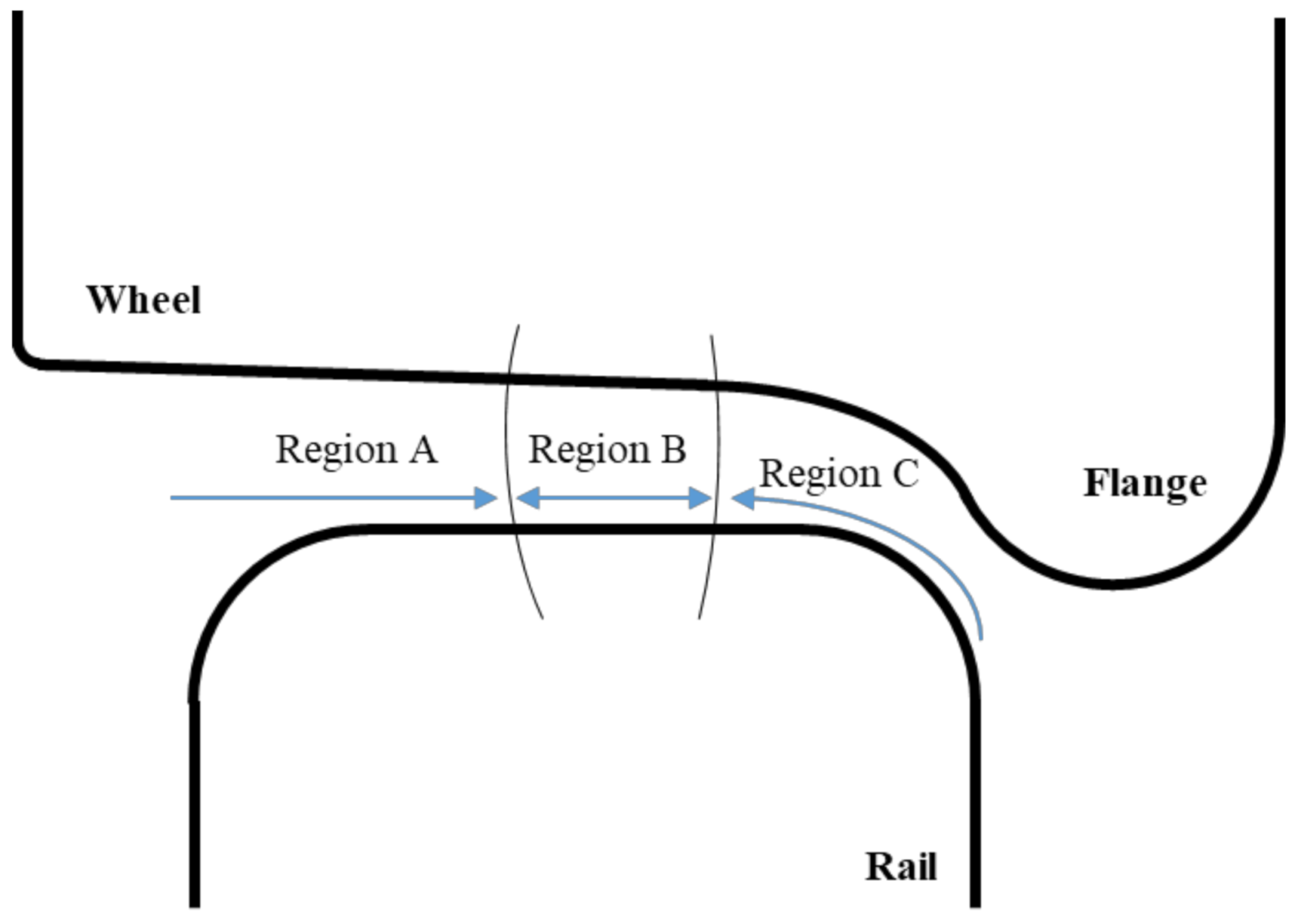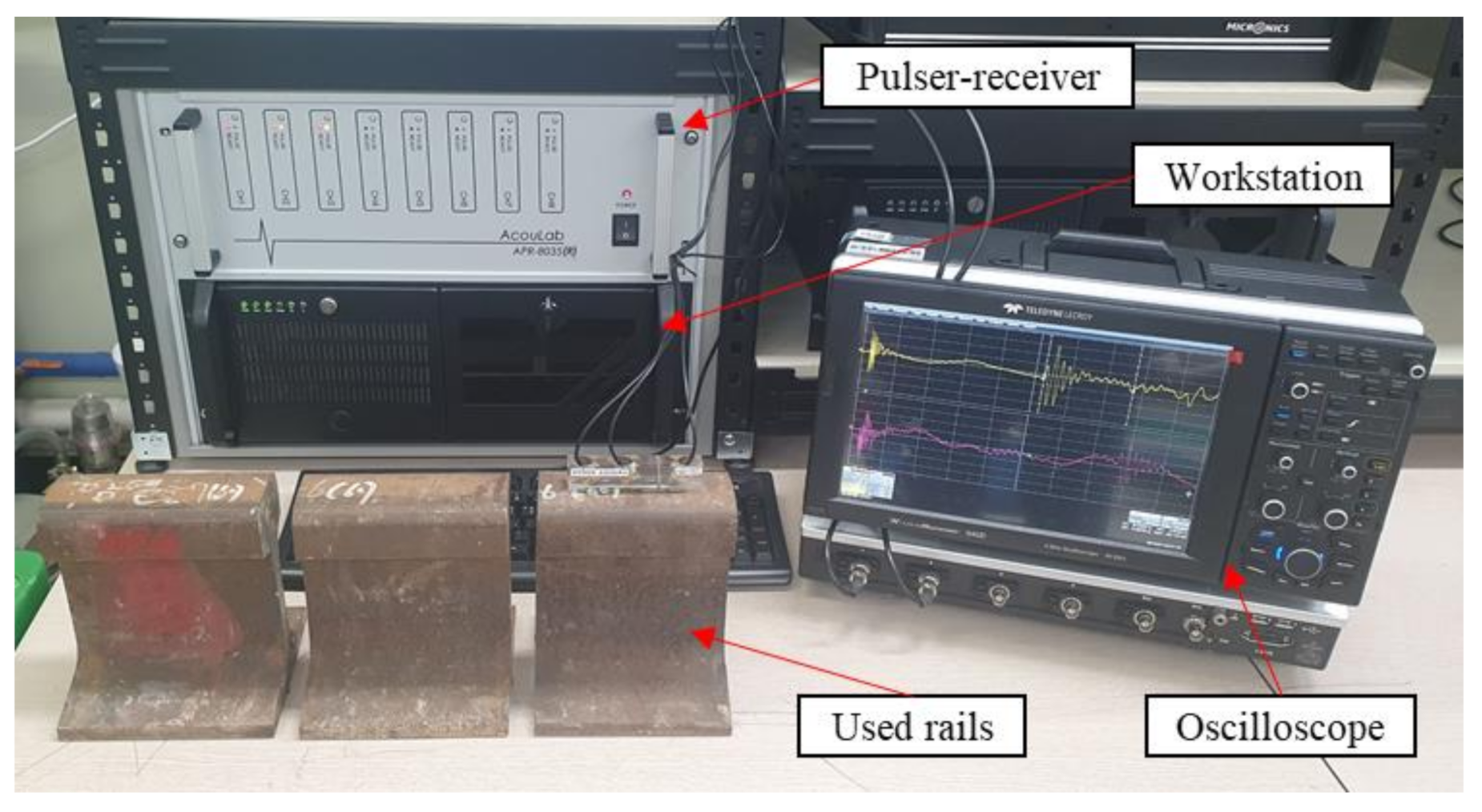Experimental Measurement of Residual Stress Distribution in Rail Specimens Using Ultrasonic LCR Waves
Abstract
:1. Introduction
2. Theoretical Background
2.1. Longitudinal Critically Refracted Wave
2.2. Distribution of Residual Stress in Rails
3. Experiments
4. Results and Discussion
5. Conclusions
- (1)
- A probe consisting of one transmitter and two receivers was fabricated using PZT piezoelectric elements with a center frequency of 2.25 MHz and a wedge made of PMMA material.
- (2)
- The acoustoelastic coefficient was calculated through a plurality of tensile tests. By analyzing the correlation between stress and travel time, it was found that the regression lines whose slope values are the acoustoelastic coefficient are very close to straight lines. This indicates that the calculated acoustoelastic coefficient values have high reliability, and stress can be measured using these values.
- (3)
- Residual stresses on used rails were measured using the calculated acoustoelastic coefficients, and their distributions were analyzed. Using rail specimens under different conditions, it was verified whether the characteristics of the residual stress inherent in the rails could be grasped through the measured values. Through this process, it has been proven that ultrasonic testing using LCR waves is a non-destructive measurement technique that can be applied for accurate residual stress measurement of used rails.
Author Contributions
Funding
Institutional Review Board Statement
Informed Consent Statement
Data Availability Statement
Conflicts of Interest
References
- Kudryavtsev, Y.; Kleiman, J. Fatigue of welded elements: Residual stresses and improvement treatments. Weld. World Lond. 2007, 51, 255. [Google Scholar]
- Rossini, N.; Dassisti, M.; Benyounis, K.; Olabi, A.G. Methods of measuring residual stresses in components. Mater. Des. 2012, 35, 572–588. [Google Scholar] [CrossRef] [Green Version]
- Kelleher, J.; Prime, M.; Buttle, D.; Mummery, P.; Webster, P.; Shackleton, J.; Withers, P. The Measurement of Residual Stress in Railway Rails by Diffraction and other Methods. J. Neutron Res. 2003, 11, 187–193. [Google Scholar] [CrossRef]
- Mirković, N.; Brajović, L.; Malović, M. Methods for determination of residual stress in rail. In Proceedings of the XVIII Scientific-Expert Conference on Railways-RAILCON 18, Niš, Serbia, 11–12 October 2018; pp. 113–116. [Google Scholar]
- Li, Z.; He, J.; Teng, J.; Wang, Y. Internal Stress Monitoring of In-Service Structural Steel Members with Ultrasonic Method. Materials 2016, 9, 223. [Google Scholar] [CrossRef] [Green Version]
- Palkowski, H.; Brück, S.; Pirling, T.; Carradò, A. Investigation on the Residual Stress State of Drawn Tubes by Numerical Simulation and Neutron Diffraction Analysis. Materials 2013, 6, 5118–5130. [Google Scholar] [CrossRef] [PubMed] [Green Version]
- Fitzpatrick, M.E.; Fry, A.T.; Holdway, P.; Kandil, F.A.; Shackleton, J.; Suominen, L. Determination of Residual Stresses by X-ray Diffraction; National Physical Laboratory: Teddington, UK, 2005. [Google Scholar]
- Buttle, D.J.; Moorthy, V.; Shaw, B.; Lord, J.D. Determination of Residual Stresses by Magnetic Methods; National Physical Laboratory: Teddington, UK, 2006. [Google Scholar]
- Mierczak, L.; Jiles, D.C.; Fantoni, G. A New Method for Evaluation of Mechanical Stress Using the Reciprocal Amplitude of Magnetic Barkhausen Noise. IEEE Trans. Magn. 2011, 47, 459–465. [Google Scholar] [CrossRef]
- Hwang, Y.I.; Kim, Y.I.; Seo, D.C.; Seo, M.K.; Lee, W.S.; Kwon, S.; Kim, K.B. Experimental Consideration of Conditions for Measuring Residual Stresses of Rails Using Magnetic Barkhausen Noise Method. Materials 2021, 14, 5374. [Google Scholar] [CrossRef] [PubMed]
- Zou, D.; Liu, T.; Liang, C.; Huang, Y.; Zhang, F.; Du, C. An experimental investigation on the health monitoring of concrete structures using piezoelectric transducers at various environmental temperatures. J. Intell. Mater. Syst. Struct. 2015, 26, 1028–1034. [Google Scholar] [CrossRef]
- Zou, D.; Liu, T.; Huang, Y.; Zhang, F.; Du, C.; Li, B. Feasibility of water seepage monitoring in concrete with embedded smart aggregates by P-wave travel time measurement. Smart Mater. Struct. 2014, 23, 067003. [Google Scholar] [CrossRef]
- Zou, D.; Liu, T.; Qiao, G.; Huang, Y.; Li, B. An experimental study on the performance of piezoceramic-based smart aggregate in water environment. IEEE Sens. J. 2014, 14, 943–944. [Google Scholar] [CrossRef]
- Ploix, M.A.; El Guerjouma, R.; Moysan, J.; Corneloup, G.; Chassignole, B. A steel welds for experimental and modeling NDT. J. Adv. Sci. 2005, 17, 76–81. [Google Scholar] [CrossRef] [Green Version]
- Spies, M.; Schneider, E. Nondestructive analysis of textures in rolled sheets by ultrasonic techniques. Texture Stress Microstruct. 1990, 12, 219–231. [Google Scholar] [CrossRef] [Green Version]
- Palanichamy, P.; Joseph, A.; Jayakumar, T.; Raj, B. Ultrasonic velocity measurements for estimation of grain size in austenitic stainless steel. NDT E Int. 1995, 28, 179–185. [Google Scholar] [CrossRef]
- Hwang, Y.I.; Sung, D.; Kim, H.J.; Song, S.J.; Kim, K.B.; Kang, S.S. Propagation and Attenuation Characteristics of an Ultrasonic Beam in Dissimilar-Metal Welds. Sensors 2020, 20, 6259. [Google Scholar] [CrossRef]
- Gür, C.H.; Cam, I. Comparison of magnetic Barkhausen noise and ultrasonic velocity measurements for microstructure evaluation of SAE 1040 and SAE 4140 steels. Mater. Charact. 2007, 58, 447–454. [Google Scholar] [CrossRef]
- Nam, Y.H.; Kim, Y.I.; Nahm, S.H. Evaluation of fracture appearance transition temperature to forged 3Cr–1Mo–0.25V steel using ultrasonic characteristics. Mater. Lett. 2006, 60, 3577–3581. [Google Scholar] [CrossRef]
- Crecraft, D. The measurement of applied and residual stresses in metals using ultrasonic waves. J. Sound Vib. 1967, 5, 173–192. [Google Scholar] [CrossRef]
- Lh’emery, A.; Calmon, P.; Chatillon, S.; Gengembre, N. Modeling of ultrasonic fields radiated by contact transducer in a component of irregular surface. Ultrasonics 2002, 40, 231–236. [Google Scholar] [CrossRef]
- Egle, D.M.; Bray, D.E. Measurement of acoustoelastic and third-order elastic constants for rail steel. J. Acoust. Soc. Am. 1976, 60, 741–744. [Google Scholar] [CrossRef]
- Li, Z.; He, J.; Teng, J.; Huang, Q.; Wang, Y. Absolute stress measurement of structural steel members with ultrasonic shear-wave spectral analysis method. Struct. Heal. Monit. 2019, 18, 216–231. [Google Scholar] [CrossRef]
- Bray, D.E.; Tang, W. Subsurface stress evaluation in steel plates and bars using the LCR ultrasonic wave. Nucl. Eng. Des. 2001, 207, 231–240. [Google Scholar] [CrossRef]
- Dos Santos, A.A., Jr.; Bray, D.E. Comparison of acoustoelastic methods to evaluate stresses in steel plates and bars. J. Press. Vessel Technol. 2002, 124, 354–358. [Google Scholar] [CrossRef]
- Andrino, M.H.; dos Santos, A.A., Jr.; Bray, D.E.; Trevisan, R.E. Stress relaxation in aluminum welding using ultrasonic method. In Proceedings of the ASME Pressure Vessels and Piping Conference, San Antonio, TX, USA, 22–26 July 2007; Volume 42835, pp. 157–165. [Google Scholar]
- Javadi, Y.; Hloch, S. Employing the LCR waves to measure longitudinal residual stresses in different depths of a stainless steel welded plate. Adv. Mater. Sci. Eng. 2013. [Google Scholar] [CrossRef] [Green Version]
- Javadi, Y.; Pirzaman, H.S.; Raeisi, M.H.; Najafabadi, M.A. Ultrasonic inspection of a welded stainless steel pipe to evaluate residual stresses through thickness. Mater. Des. 2013, 49, 591–601. [Google Scholar] [CrossRef]
- Javadi, Y.; Plevris, V.; Najafabadi, M.A. Using LCR ultrasonic method to evaluate residual stress in dissimilar welded pipes. Int. J. Innov. Manag. Technol. 2013, 4, 170–174. [Google Scholar]
- Javadi, Y.; Najafabadi, M.A. Comparison between contact and immersion ultrasonic method to evaluate welding residual stresses of dissimilar joints. Mater. Des. 2013, 47, 473–482. [Google Scholar] [CrossRef]
- Javadi, Y.; Akhlaghi, M.; Najafabadi, M.A. Nondestructive Evaluation of Welding Residual Stresses in Austenitic Stainless Steel Plates. Res. Nondestruct. Evaluation 2014, 25, 30–43. [Google Scholar] [CrossRef]
- Javadi, Y.; Sadeghi, S.; Najafabadi, M.A. Taguchi optimization and ultrasonic measurement of residual stresses in the friction stir welding. Mater. Des. 2014, 55, 27–34. [Google Scholar] [CrossRef]
- Sadeghi, S.; Najafabadi, M.A.; Javadi, Y.; Mohammadisefat, M. Using ultrasonic waves and finite element method to evaluate through-thickness residual stresses distribution in the friction stir welding of aluminum plates. Mater. Des. 2013, 52, 870–880. [Google Scholar] [CrossRef]
- Javadi, Y.; Akhlaghi, M.; Najafabadi, M.A. Using finite element and ultrasonic method to evaluate welding longitudinal residual stress through the thickness in austenitic stainless steel plates. Mater. Des. 2013, 45, 628–642. [Google Scholar] [CrossRef]
- Liu, H.; Li, Y.; Li, T.; Zhang, X.; Liu, Y.; Liu, K.; Wang, Y. Influence factors analysis and accuracy improvement for stress measurement using ultrasonic longitudinal critically refracted (LCR) wave. Appl. Acoust. 2018, 141, 178–187. [Google Scholar] [CrossRef]
- Santos, A.A.; Bray, D.E. Ultrasonic stress measurement using PC based and commercial flaw detectors. Rev. Sci. Instrum. 2000, 71, 3464–3469. [Google Scholar] [CrossRef] [Green Version]
- Martin, L.P.; Dadon, D.; Rosen, M. Evaluation of Ultrasonically Determined Elasticity-Porosity Relations in Zinc Oxide. J. Am. Ceram. Soc. 1996, 79, 1281–1289. [Google Scholar] [CrossRef]
- Jun, T.S.; Hofmann, F.; Belnoue, J.; Song, X.; Hofmann, M.; Korsunsky, A.M. Triaxial residual strains in a railway rail measured by neutron diffraction. J. Strain Anal. Eng. Des. 2009, 44, 563–568. [Google Scholar] [CrossRef]
- Webster, P.J.; Hughes, D.J.; Mills, G.; Vaughan, G.B.M. Residual Stresses in Railway Rails—The FaME38. Mater. Sci. Forum 2002, 404–407, 767–772. [Google Scholar] [CrossRef]
- Soleimani, H.; Moavenian, M. Tribological Aspects of Wheel–Rail Contact: A Review of Wear Mechanisms and Effective Factors on Rolling Contact Fatigue. Urban. Rail Transit. 2017, 3, 227–237. [Google Scholar] [CrossRef] [Green Version]
- Lo, K.H.; Mummery, P.; Buttle, D. Characterisation of residual principal stresses and their implications on failure of railway rails. Eng. Fail. Anal. 2010, 17, 1273–1284. [Google Scholar] [CrossRef]
- Railway Technology Review Committee. KRS TR 0001-15(R), Rail; Korean Railway Standards: Sejong, Korea, 2006. [Google Scholar]
- Song, W.; Xu, C.; Pan, Q.; Song, J. Nondestructive testing and characterization of residual stress field using an ultrasonic method. Chin. J. Mech. Eng. 2015, 29, 365–371. [Google Scholar] [CrossRef]











| Yield Strength [MPa] | Elongation Percentage [%] | Hardness [HBW] | Modulus of Elasticity [MPa] | Linear Expansion Coefficient [mm/°C] |
|---|---|---|---|---|
| >800 | >10 | >235 | 210,000 | 1.14 × 10−5 |
Publisher’s Note: MDPI stays neutral with regard to jurisdictional claims in published maps and institutional affiliations. |
© 2021 by the authors. Licensee MDPI, Basel, Switzerland. This article is an open access article distributed under the terms and conditions of the Creative Commons Attribution (CC BY) license (https://creativecommons.org/licenses/by/4.0/).
Share and Cite
Hwang, Y.-I.; Kim, G.; Kim, Y.-I.; Park, J.-H.; Choi, M.Y.; Kim, K.-B. Experimental Measurement of Residual Stress Distribution in Rail Specimens Using Ultrasonic LCR Waves. Appl. Sci. 2021, 11, 9306. https://doi.org/10.3390/app11199306
Hwang Y-I, Kim G, Kim Y-I, Park J-H, Choi MY, Kim K-B. Experimental Measurement of Residual Stress Distribution in Rail Specimens Using Ultrasonic LCR Waves. Applied Sciences. 2021; 11(19):9306. https://doi.org/10.3390/app11199306
Chicago/Turabian StyleHwang, Young-In, Geonwoo Kim, Yong-Il Kim, Jeong-Hak Park, Man Yong Choi, and Ki-Bok Kim. 2021. "Experimental Measurement of Residual Stress Distribution in Rail Specimens Using Ultrasonic LCR Waves" Applied Sciences 11, no. 19: 9306. https://doi.org/10.3390/app11199306






